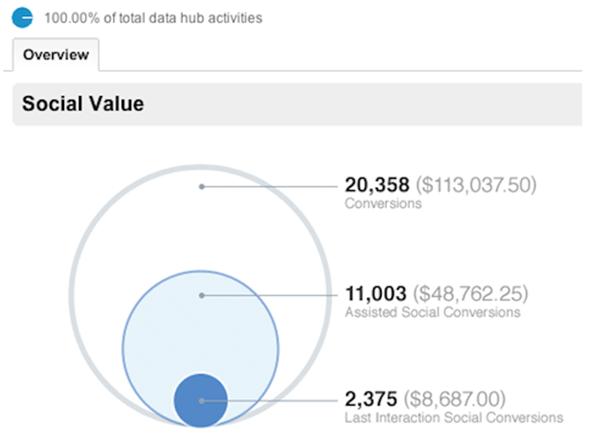“Suddenly the fingers of a man’s hand emerged and began writing opposite the lampstand on the plaster of the wall of the king’s palace, and the king saw the back of the hand that did the writing. Then the king’s face grew pale and his thoughts alarmed him, and his hip joints went slack and his knees began knocking together.”
The Famous Writing on the Wall…
It was King Belshazzar of Babylon whose knees began knocking when he saw the handwriting on the wall. After the interpretation was given, “God has numbered your kingdom and put an end to it,” it was that same night that his kingdom was taken over by Darius the Mede.
Many SEOs can relate to Balshazzar. We’ve spent the last 15 years building an industry around keywords, tags, and links, but Google has made clear the old kingdom is coming to an end, and a new regime is here.
Defining Social SEO
For lack of a better name, we’ll call this new world, “Social SEO.” It’s not a great name, because parts of SEO have been social for a long time, but this is the first time that social signals have been considered a primary ranking factor. Let’s look at what that means, and how it came about.
Changing the System
At first, Facebook’s social graph was merely a way of showing how popular someone was. I have 50 friends, and you have 250 friends. Why would that matter to a search engine? It matters because friendships are based on trust, and search engines use trust as a signal for quality. If you think a page is useful, and I trust you as a person, there’s a good chance that I’ll think the page is useful as well.
As the social graph matured, the search engines realized its usefulness, and began including social signals in their algorithms. Danny Sullivan from SearchEngineLand confirmed this with Google and Bing in 2010.
This means that SEOs must adjust their strategy, and come up with new ways to optimize these new relationship signals. To help you understand Social SEO in greater detail and to capitalize on the associated new opportunities this presents to you as a marketer, you can find a list of five insights into Social SEO as follows:
Insight 1: Where Are the Signals Coming From?
In June of 2012, SearchMetrics put out research showing the correlation between social activity’s and search rankings in Google. The study showed that activity from Facebook and Twitter correlates very strongly with high rankings in Google. The study looked at Google+, but at the time Google+ was less than a year old. Since then, Google has placed significant emphasis on their homegrown social network, and I’m sure this year’s study will reflect that.

From those findings, and our own intuition, we conclude there are four social networks search engines rely on for their signals: Google+, Facebook, Twitter, and YouTube.
Insight 2: Why YouTube?
Most people think Google+ is simply a social network like Facebook. What they don’t realize is that Google+ is actually of a system for collecting and displaying social data across all of Google’s products, including their social network.
At the core of most of the products that Google creates is a search bar: Chrome, Android, Google Maps, Gmail, YouTube—you name it. Search is the factor that makes Google’s products better than their competitors. Google+ is important, because it’s a layer of social Google wants to incorporate across its entire portfolio.
For example, let’s say I’m planning a road trip across the United States. I start mapping out my route using Google Maps. Wouldn’t it be great if I could see the routes my friends have taken on their road trips, landmarks they’ve stopped at, and restaurants they’ve enjoyed eating at? Google+ was designed to deliver that social experience to Google Maps. But in order to deliver that personalized experience, Google needs to know who you are, who your friends are and what things you like.
Google+ goes beyond just displaying a personalized experience within its suite of products; it also collects data from them.
For example, let’s say you like Rainn Wilson’s videos on YouTube so much that you decide to subscribe to his SoulPancake channel. By subscribing, you are joining a group of others who share a common interest: SoulPancake videos. This informal grouping is a signal to Google that you have something in common with others in that group. Google may use that signal to recommend web results it may think you’ll like, based on the fact that others in that group liked it.
Among Google products, YouTube’s popularity and levels of engagement (e.g., 800 million monthly unique visitors, more than 4 billion daily video views, etc.) make it a particularly important source of signal generation, which can then be tied back to your profile and social graph through Google+.
Insight 3: A New Strategy and New Team Roles
New signals require new tactics, and new tactics require new strategies.
Managers who plan on adding a social element to their SEO campaign should evaluate their current resources and team makeup.
A skilled technical SEO may not be the best-suited person to execute a relationship-building campaign. Likewise, a community manager may not enjoy keyword research and data analysis.
There are only a small number of individuals who contain a deep understanding of both SEO and Social. If you have such a person on staff, they should develop and lead your new Social SEO strategy, while specialists in their respective fields execute the tactics.
Insight 4: Adjusted KPIs
Rankings matter very little in a world where everyone sees different search results.
Like traditional SEO campaigns, Social SEO still uses conversions and organic traffic as primary KPIs, but their affinity for rankings has diminished.
Secondary KPIs such as social follower growth, influence scores, and content engagement metrics can act as indicators that the campaign is moving in the right direction, but shouldn’t be given much weight individually.

Google and other analytics providers are starting to recognize the importance of measuring social activities, and have begun to offer reports such as Google Analytics’ Social Assisted Conversions in an effort to tie ROI to social actions.
Rankings, in aggregate, can be useful as another directional measurement, but it means very little on an individual keyword level, especially since Google is hiding a great deal of keyword referral data. However, certain objectives, such as reputation management, may make rank tracking a more important KPI for some.
Insight 5: New Tools of the Trade
Social is a high-touch environment, and requires constant attention. Since attention isn’t scalable, we need technology to scale for us. Here are a few useful tools for your Social SEO campaigns:
- HootSuite: One of the most popular social management platforms, HootSuit allows a team to monitor, analyze, and engage with audiences across multiple social networks simultaneously. The scheduled tweets lets campaign managers queue up messages to be sent automatically at scheduled times.
- IFTTT: A unique, rule-based platform where you can automate activities based on social actions. For example, you can create a rule to email the team whenever someone mentions your brand in a tweet.
- Triberr: A content curation and sharing platform. A team can search for and join relevant industry groups to access a constant stream of fresh content that can be automatically shared with social audiences. Likewise, teams can create and share their own content with their social networks.
Additional Research
The insights listed above are from a newly published eBook from Catalyst, “The Art of Social SEO: Mastering the Art of Social SEO.” I was one of several SEOs who contributed to the project. For additional Social SEO insights, download a free copy of the publication here.
In Closing
There once was a day when SEOs could make a few tweaks to a website, and rankings would improve. Now, we need to tweak the website, create new content, ask others to link to the content, share the content, and comment on it. It is a combined effort from Web development, copywriting, design, PR, influencer marketing, social, and in some cases, paid media (if you need to drive traffic to content for additional engagement).
We can no longer go off to do SEO research, strategy, and tactical execution in a silo. Search engine algorithms are more holistic than ever, and SEOs need to be as well. This is our role in Google’s new kingdom. It’s time we embrace the change, because like King Belshazzar, the writing is on the wall.



